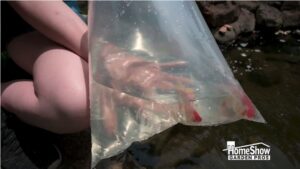Houston Organic Garden Tips & Advice
Crape Myrtle Care: Planting, Pruning & Feeding Tips
Transcript:
Sherri Harrah:
Hi, I’m Sherri Harrah with Home Show Garden Pros, and we are going to talk crape myrtles.
Crape myrtles are a beloved tree, it’s a staple tree in the Gulf Coast region, and there’s so many different beautiful crape myrtles that bloom so much of the summertime. So I want to give a few tips and tricks on planting, and maintaining, and actually picking out the perfect crape myrtle for your space. Now, we hear don’t do crape myrtle in the springtime in Houston, and I am a big believer in no crape myrtle allowed. So the biggest thing that you can do is pick the right crape myrtle for your yard, in your space, so you don’t have to cut it back.
So, there’s several different varieties. There’s the Pocomoke over here, that one maxes out at three to four foot tall, so a small bush. There’s the Dynamite Red or Red Rocket varieties, as well, 10 to 15 foot. Acoma, which is back here with the beautiful white flowers. It maxes out at about 10 foot and has just a nice, beautiful cascading effect to it. Or these varieties here, there’s Tuscarora and Catawba, they’re going to get 15 to 25 foot tall. So, planting the right crape myrtle for your project is number one rule of thumb to have success with your crape myrtles.
Next, you’re going to have to maintain these crape myrtles, and you don’t need to cut the top off, but pruning them up from the bottom is how you maintain that tree form. Their natural habit is going to be a multi-trunked, almost bush-like. So you would come in here and just selectively prune out these smaller branches to make it look more tree-form. So that’s one thing that you’ll need to do for maintenance.
And then, the next thing you’ll want to do is, after a big, heavy bloom, you want to promote more blooming, so through pruning, you can do that. And so you can see here this is new growth with cute little new buds coming on, and over here we have spent flowers, and you can tell the difference, you see, when I squish on this, nothing comes out. They turn into seeds. And then if I squish on this one, see how that comes out? Fun little fact, if that flower opens on a cloudy day, you’re going to get more of a whitish tinge to the flower than that true red, so that’s really cool, but on these spent ones, you’re going to want to cut right back on the spent flower, so this is not going to make any more flowers, and they’re all going to just go to seed and fall off. That will let the plant put more energy into these new little buds here. So, when we’re maintaining our crape myrtles, it’s cutting them up from the bottom to make them look more tree-form, and then cutting off spent flowers.
The next thing we want to do is feed them correctly, so Nelson’s has crape myrtle food. It’s as easy as that. So, you would just sprinkle this around the base, depending on the size of the crape myrtle. Just sprinkle this on the base of your crape myrtle. Now, in your yard, you’re going to put a little bit more because they’re in the ground. In pots, you wouldn’t do as much. So, this throughout the growing season, starting when they start to leaf out in the springtime, another feed in the summer, and then one more in the fall before we go dormant, is going to help keep them happy and healthy.
Now, let’s just say you’re wanting to plant a crape myrtle. We’ve got to do a few things to prepare the soil. You would dig your hole twice the width, so a container this big, you’re just going to go this big and not quite as deep. So when you dig your hole, you’re going to want to add a high-quality compost. Something like this, Coast of Maine, this is their Quoddy Blend, and it’s got sea source elements in it. And you can see it’s beautiful, rich. It just feels good and smells good.
So you’re going to mix this with the soil that you take out of the hole, about a third to two-thirds of the native soil, so a third compost to two-thirds of the native soil. Mix it in. Put your soil nice and level in the bottom of the pot, and then come through with the Genesis Transplant Mix. This is by Nelson’s, and what this is loaded with beneficial mycorrhizae that’s going to help get the plant off to a great start, and then I always add in my Azomite when I’m planting because this is going to help not only with the root production, but it’s going to help with color and vigor of the plant.
So, by doing these things, we’re getting the plant off to a great start. We get it planted, everything is nestled in, and then we put a nice little layer of the Black Velvet Mulch by Landscapers Pride. It is not dyed. It is aged to be this nice, pretty, rich, chocolatey color. So by doing these things, we’re getting the plant off to a great start.
Now, fall is the best time to plant our crape myrtles, but here in the Gulf Coast, you can plant them anytime. The biggest thing to think of is in the middle of summer, you plant a new crape myrtle, you do not want to rely on the sprinkler system, so do some hand watering through the first summer, and you should be good for the next spring. So, hope this helps.



